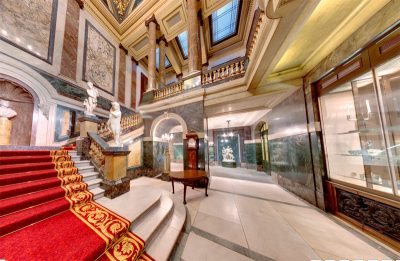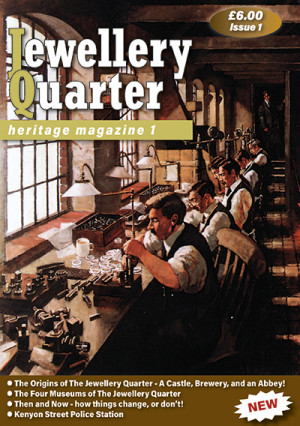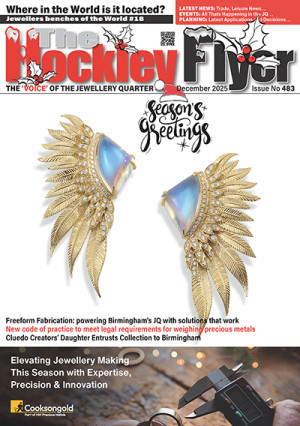 The Goldsmith’s Craft and Design Council has awarded Fred Rich, one of Britain’s most dynamic and exciting art enamellers, its two most prestigious awards for his entry in the 2003 Goldsmiths’ Craftsmanship and Design Awards competition. The prize winners were announced on March 3 as part of a ceremony at the Goldsmiths’ Hall, which also marked the opening of an exhibition of the best entries.
The Goldsmith’s Craft and Design Council has awarded Fred Rich, one of Britain’s most dynamic and exciting art enamellers, its two most prestigious awards for his entry in the 2003 Goldsmiths’ Craftsmanship and Design Awards competition. The prize winners were announced on March 3 as part of a ceremony at the Goldsmiths’ Hall, which also marked the opening of an exhibition of the best entries.
The Goldsmiths’ Craft & Design Council Awards are an annual event and are part of the Goldsmiths’ Craft and Design Council’s ongoing programme to encourage and promote excellence in both craftsmanship and design among all those involved in goldsmithing, silversmithing, jewellery and the allied crafts, including trainees and students studying at universities and colleges.
The competition, now in its 95th year, is supported by The Worshipful Company of Goldsmiths and other companies and individuals from within the industry.
The highlights of the awards ceremony are the announcement of The Goldsmiths’ Company Award, presented to a piece of finished work that is judged to have achieved the highest standards of both craftsmanship and design, and the Jacques Cartier Memorial Award for exceptional and outstanding craftsmanship.
Both the Goldsmiths’ Company Award and the Jacques Cartier Award were awarded to Fred Rich, who works from his studio in Croydon, for his two impressive complementary enamelled vases. Commissioned to mark the Queen’s Golden Jubilee, the vases celebrate the British countryside – one focuses on woods and the other on fields. Both are exquisitely worked in vibrant enamels with charming scenes of birds, butterflies, flowers, foliage and undulating fields.
Brian Hill, Chairman of The Goldsmiths’ Craft and Design Council, said: “The judges’ decision to present Fred Rich with both the Goldsmiths’ Company Award and the Jacques Cartier Memorial Award was unanimous. His vases fully answered the criteria of each award and with their superlative enamelling they are a marvel of technical virtuosity which on this occasion was unsurpassed.”
This year’s competition attracted more than 700 entrants with some individuals entering more than one piece. Brian Hill commented: “We were delighted at the response to this year’s awards. In keeping with previous years it continues to attract a substantial number of entries and overall the standard was high. If anything there were a greater proportion of student entries and we would hope that next year there might be more industry and professional designer maker participation to achieve a better balance.”
In the senior category, a special Council award was presented to Brent Sutcliffe for his miniature model of a violin and stand, which he made from 18carat white gold. Two other special Council awards went to Simon Wolff, in the category of technical innovation, for his three tension set rings in titanium and aluminium, and to Robert Elderton for his modelling of three cameos set in a plaster frame commemorating a marriage.
Raymond Hood won the best trainee/student award for his outstanding engraving in silver of the coat of arms of Alexander Mountbatten, first Marquess of Carisbrooke and the College Award was presented to Kent Institute of Art & Design.
Other notable gold prize winners included Sebastian Buescher, whose 11 metre long concept based necklace surpassed all competition in the fashion jewellers category, and Bernadine Chelvanayagam, in the fine jewellery category, for her ring incorporating moving discs. A gold prize for prototype production jewellery was awarded to Maria Westermak for her cast link bracelet.
The recently introduced technical innovation categories proved to be very popular. Among the entries in this section was David Poston’s dramatic sculptural gold bracelet, an example of how laser technology can be used in jewellery production. Thin sheets of 18carat gold were welded onto a wooden core thereby producing a bracelet which looks extremely heavy but is in fact quite lightweight. David Poston was awarded a gold for this technically innovative bracelet as indeed was Jonathan Swan for his two rings in palladium and 18carat yellow and white gold, twisted together by a programmable logic controller. The second relatively new category in the competition was for a window design or display, which was won by Carole Raines, from Peterborough College which also produced last year’s winner in this category.



